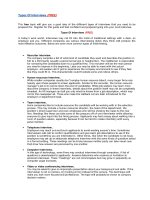Vector equilibrium problems with new types of generalized monotonicity
Bạn đang xem bản rút gọn của tài liệu. Xem và tải ngay bản đầy đủ của tài liệu tại đây (136.42 KB, 8 trang )
Yugoslav Journal on Operations Research
23(2013) Number 2, 213–220
DOI: 10.2298/YJOR130107024M
VECTOR EQUILIBRIUM PROBLEMS WITH
NEW TYPES OF GENERALIZED
MONOTONICITY
Nihar Kumar MAHATO
Department of Mathematics, Indian Institute of Technology Kharagpur
Kharagpur-721302, India.
Chandal NAHAK1
Department of Mathematics, Indian Institute of Technology Kharagpur
Kharagpur-721302, India.
Received: Junuary 2013 / Accepted: May 2013
Abstract: In this paper, we introduce the concept of generalized relaxed αpseudomonotonicity for vector valued bi-functions. By using the KKM technique,
we obtain some substantial results of the vector equilibrium problems with generalized relaxed α-pseudomonotonicity assumptions in reflexive Banach spaces.
Several examples are provided to illustrate our investigations.
Keywords: Vector equilibrium problem, generalized relaxed α-pseudomonotonicity,
KKM mapping.
MSC: 49J40; 47H10; 91B52; 90C30
1 Corresponding
author.
213
214
N.K. Mahato and C. Nahak / Vector Equilibrium Problems
1. INTRODUCTION
Equilibrium problems in the sense of Blum and Oettli [1] has vast applications in the several branches of pure and applied sciences. The equilibrium
problem includes many mathematical problems as its particular cases, e.g., mathematical programming problems, complementary problems, variational inequality
problems, and fixed point problems. Inspired by the notion of vector variational
inequality problem introduced and studied by Giannessi [2], Chen and Yang [3],
the equilibrium problem has been extended to vector equilibrium problem. The
vector equilibrium problem contains vector optimization problems, vector variational inequality problems, and vector complementarity problems as a special
case.
Let Y be a real Banach space and C be a nonempty subset of Y . C is
called a cone if λC ⊂ C, for any λ ≥ 0. Further, the cone C is called convex cone
if C + C ⊂ C. C is pointed cone if C is cone and C ∩ (−C) = {0}.
Now, consider C ⊆ Y is a pointed closed convex cone with int C = ∅,
where int C is the set of interior points of C. Then, C induce a vector ordering in
Y as follows:
x ≤ y ⇔ y − x ∈ C;
x y ⇔y−x∈
/ C;
x < y ⇔ y − x ∈ intC;
x≮y ⇔y−x∈
/ intC.
By (Y, C), we denote an ordered space with the ordering of Y defined by set C.
Now, let K ⊆ X be nonempty closed convex subset of a real reflexive
Banach space X and (Y, C) be an ordered Banach space induced by the pointed
closed convex cone C with int C = ∅. The vector equilibrium problem (for short,
(VEP)) for the bi-function f : K × K → Y is to find x ∈ K, such that
f (x, y) ≮ 0, ∀y ∈ K,
(1.1)
with f (x, x) = 0, ∀x ∈ K.
In the study of vector equilibrium problems and vector variational inequalities, the generalized monotonicity plays an important role. In recent years, a number of authors have proposed many important notions of generalized monotonicities
such as monotonicity, pseudomonotonicity, quasimonotonicity, relaxed monotonicity, relaxed η-α monotonicity, relaxed η-α pseudomonotonicity, see, [4, 5, 6, 7, 8].
In 2003, Fang and Huang [6] introduced the concept of relaxed η-α monotonicity and obtained the existence of solutions for the variational-like inequalities in
the reflexive Banach spaces. Very recently, Bai et al. [4] introduced a new concept of relaxed η-α pseudomonotone mappings and obtained the solutions for the
variational-like inequalities. In 2007, Wu and Huang [8] extended the idea of Bai et
al. [4] for vector variational-like inequality problem. Wu and Huang [8] defined the
concepts of relaxed η-α pseudomonotone mappings to study vector variational-like
N.K. Mahato and C. Nahak / Vector Equilibrium Problems
215
inequality problem in Banach spaces. It is well known that many results of variational inequality problems can be adapted to equilibrium problems under some
suitable modifications, which is a very fundamental phenomenon in this field.
Inspired and motivated by [4, 6, 8, 9], in this paper we introduce the concept of generalized relaxed α-pseudomonotonicity for vector valued bi-functions.
By using the KKM technique, we obtain the existence of solutions for (VEP) with
generalized relaxed α-pseudomonotone mappings in reflexive Banach spaces.
2. PRELIMINARIES
Throughout the paper, unless otherwise specified, K is a nonempty closed
convex subset of a reflexive Banach space X and (Y, C) is an ordered Banach
space induced by the pointed closed convex cone C with int C = ∅. The following
definitions and lemma will be useful in our paper.
Definition 2.1. The mapping f : X → Y is C-convex on X if f (tx + (1 − t)y) ≤
tf (x) + (1 − t)f (y), for all x, y ∈ X, t ∈ [0, 1].
Definition 2.2. A mapping f : K → Y is said to be completely continuous if for
any sequence {xn } ∈ K, xn
x0 ∈ K weakly, then f (xn ) → f (x0 ).
Lemma 2.1. ([10, 3]) Let (Y, C) be an ordered Banach space induced by the
pointed closed convex cone C with int C = ∅. Then for any x, y, z ∈ Y , the
following holds:
z ≮ x ≥ y implies y ≯ z;
z ≯ x ≤ y implies y ≮ z.
Definition 2.3. Let f : K → 2X be a set-valued mapping. Then f is said to be
KKM mapping if for any finite subset {y1 , y2 , . . . , yn } of K we have co{y1 , y2 , . . . , yn } ⊂
n
f (yi ), where co{y1 , y2 , . . . , yn } denotes the convex hull of y1 , y2 , . . . , yn .
i=1
Lemma 2.2. [11] Let M be a nonempty subset of a Hausdorff topological vector
space X and let f : M → 2X be a KKM mapping. If f (y) is closed in X for all
y ∈ M and compact for some y ∈ M , then
f (y) = ∅.
y∈M
3. (VEP) WITH GENERALIZED RELAXED
α-PSEUDOMONOTONICITY
In this section, we define the definition of generalized relaxed α-pseudomonotone
mappings to study (VEP).
216
N.K. Mahato and C. Nahak / Vector Equilibrium Problems
Definition 3.4. A mapping f : K × K → Y is said to be generalized relaxed
α-pseudomonotone if there exists a function α : X × X → Y with
α(ty + (1 − t)x, x)
= 0,
t→0
t
lim
such that
f (x, y) ≮ 0 ⇒ f (y, x) ≤ α(y, x), ∀x, y ∈ K.
(3.1)
Remark 3.1. (i) If there exists a function α : X → Y with α(tx) = k(t)α(x)
for all t > 0 and x ∈ X, where k is function from (0, ∞) to (0, ∞) with
k(t)
lim
= 0, such that for every pair of points x, y ∈ K, we have
t→0 t
f (x, y) ≮ 0 ⇒ f (y, x) ≤ α(y − x),
(3.2)
then f is said to be weakly relaxed α-pseudomonotone (see [9]).
(ii) If α ≡ 0 then from (3.1) it follows that
f (x, y) ≮ 0 ⇒ f (y, x) ≤ 0, ∀x, y ∈ K, and f is said to be pseudomonotene.
(iii) If Y = R, and α(tx) = k(t)α(x) for all t > 0 and x ∈ X, where k is function
k(t)
from (0, ∞) to (0, ∞) with lim
= 0, then (3.2) reduces to that for any
t→0 t
x, y ∈ K,
f (x, y) ≥ 0 ⇒ f (y, x) ≤ α(y − x),
(3.3)
and f is said to be weakly relaxed α-pseudomonotone (see [9]).
So from the above definitions, it follows that pseudomonotonicity ⇒ weakly
relaxed α-pseudomonotonicity ⇒ generalized relaxed α-pseudomonotonicity. But
the converse implications are not true in general, which is shown by the following
examples. The Example 3.1 shows that weakly relaxed α-pseudomonotone may
not be pseudomonotone, and The Example 3.2 shows that generalized relaxed αpseudomonotone mapping neither pseudomonotone nor relaxed α-pseudomonotone
mapping.
Example 3.1. [9] Let X = R, K = [1, 10], Y = R2 , C = R2+ , and
x−y−1
, x ≥ y;
x−y−1
f (x, y) =
x+y−1
, x < y.
x+y−1
Then f is weakly relaxed α-pseudomonotone mapping with α(x) =
X, but f is not pseudomonotone.
20x2
20x2
, ∀x ∈
N.K. Mahato and C. Nahak / Vector Equilibrium Problems
217
Example 3.2. Let X = R, K is any nonempty closed convex subset of R, Y = R2 ,
C = R2+ , and
f (x, y) =
(sin x − sin y)2
(sin x − sin y)2
.
Then f is generalized relaxed α-pseudomonotone mapping with
2(sin x − sin y)2
2(sin x − sin y)2
α(x, y) =
, ∀x, y ∈ X.
But f is not pseudomonotone, in fact
(sin y − sin x)2
(sin x − sin y)2
≮ 0, for x = y ⇒ f (y, x) =
f (x, y) =
2
(sin x − sin y)
(sin y − sin x)2
0, for x = y. Again, f is not weakly relaxed α-pseudomonotone mapping as the
function α is not a function of (y − x).
Theorem 3.1. Let K be a nonempty closed convex subset of a reflexive Banach
space E and (Y, C) is an ordered Banach space induced by the pointed closed
convex cone C with int C = ∅. Suppose f : K × K → Y be hemicontinuous in
the first argument and generalized relaxed α-pseudomonotone. Let the following
condition hold:
(i) for fixed z ∈ K, the mapping x → f (z, x) is C-convex.
Then x ∈ K is a solution of (1.1) if and only if
f (y, x) ≤ α(y, x), ∀y ∈ K.
(3.4)
Proof. Assume that x is a solution of (VEP) (1.1), i.e., f (x, y) ≮ 0, ∀y ∈ K.
Since f is generalized relaxed α-pseudomonotone, we have f (y, x) ≤ α(y, x), ∀y ∈
K, which proved (3.4).
Conversely, suppose there exists an x ∈ K satisfying (3.4). Choose any point
y ∈ K and consider xt = ty + (1 − t)x, t ∈ [0, 1]. Therefore from (3.4), we have
f (xt , x) ≤ α(xt , x).
(3.5)
Now condition (i) implies,
0 = f (xt , xt )) ≤ tf (xt , y) + (1 − t)f (xt , x)
⇒ t[f (xt , x) − f (xt , y)] ≤ f (xt , x).
From (3.5) and (3.6), we have
f (xt , x) − f (xt , y) ≤
α(xt , x)
, ∀y ∈ K.
t
Since f is hemicontinuous in the first argument and taking t → 0, we get
f (x, y) ≥ 0 ⇒ f (x, y) ≮ 0, ∀y ∈ K.
Hence x is a solution of (VEP).
(3.6)
218
N.K. Mahato and C. Nahak / Vector Equilibrium Problems
Theorem 3.2. Let K be a nonempty closed bounded convex subset of a reflexive
Banach space E and (Y, C) is an ordered Banach space induced by the pointed
closed convex cone C with int C = ∅. Suppose f : K × K → Y be hemicontinuous
in the first argument and generalized relaxed α-pseudomonotone. Let the following
conditions hold:
(i) for fixed z ∈ K, the mapping x → f (z, x) is C-convex and completely continuous;
(ii) α : X × X → Y is completely continuous in the second argument.
Then the (VEP) has a solution.
Proof. Consider the set valued mappings F : K → 2X and G : K → 2X such that
F (y) = {x ∈ K : f (x, y) ≮ 0}, ∀y ∈ K,
and
G(y) = {x ∈ K : f (y, x) ≤ α(y, x)}, ∀y ∈ K.
Now, x ∈ K solves (VEP) if and only if x ∈
F (y). Thus it suffices to prove
y∈K
F (y) = ∅. First to show that F is a KKM mapping.
y∈K
If possible let F is not a KKM mapping. Then there exists {x1 , x2 , . . . , xm } ⊂ K
such that
m
co{x1 , x2 , . . . , xm }
m
x0 =
F (xi ), that means there exists a x0 ∈ co{x1 , x2 , . . . , xm },
i=1
m
ti xi where ti ≥ 0, i = 1, 2, . . . , m,
i=1
m
ti = 1, but x0 ∈
/
i=1
Hence, f (x0 , xi ) < 0; for i = 1, 2, . . . , m.
From (i), it follows that
F (xi ).
i=1
m
0 = f (x0 , x0 ) ≤
ti f (x0 , xi ) < 0,
i=1
which is a contradiction. Hence F is KKM mapping.
From the generalized relaxed α-pseudomonotonicity of f , it follows that F (y) ⊂
G(y), ∀y ∈ K. Therefore G is also a KKM mapping.
Since K is closed, bounded and convex, we know that K is weakly compact. From
the assumptions, we know that G(y) is weakly closed for all y ∈ K. In fact,
since x → f (z, x) is C-convex and completely continuous, and α is completely
continuous in the second argument. G(y) is weakly closed for all y ∈ K and so
G(y) is weakly compact in K for all y ∈ K. Hence, from Lemma 2.2 and Theorem
3.1 follows that
F (y) =
G(y) = ∅.
y∈K
y∈K
So there exists x ∈ K such that f (x, y) ≮ 0, ∀y ∈ K, i.e. (VEP) (1.1) has a
solution.
N.K. Mahato and C. Nahak / Vector Equilibrium Problems
219
Theorem 3.3. Let K be a nonempty closed unbounded convex subset of a reflexive Banach space E and (Y, C) is an ordered Banach space induced by the pointed
closed convex cone C with int C = ∅. Suppose f : K × K → Y be hemicontinuous in the first argument and generalized relaxed α-pseudomonotone. Let the
following conditions hold:
(i) for fixed z ∈ K, the mapping x → f (z, x) is C-convex and completely continuous;
(ii) α : X × X → Y is completely continuous in the second argument;
(iii) f is weakly coercive that is there exists x0 ∈ K such that
f (x, x0 ) < 0, whenever x → +∞ and x ∈ K.
Then (VEP) has a solution.
Proof. For r > 0, assume Br = {y ∈ K : y ≤ r}.
Consider the problem: find xr ∈ K ∩ Br such that
f (xr , y) ≮ 0, ∀y ∈ K ∩ Br .
(3.7)
By Theorem 3.2, we know that problem (3.7) has solution xr ∈ K ∩ Br .
Choose x0 < r with x0 as in condition (iii). Then x0 ∈ K ∩ Br and
f (xr , x0 ) ≮ 0.
(3.8)
If xr = r for all r, we may choose r large enough so that by the assumption (iii)
imply that f (xr , x0 ) < 0, which contradicts (3.8).
Therefore, there exists r such that xr < r. For any y ∈ K, we can choose
0 < t < 1 small enough such that xr + t(y − xr ) ∈ K ∩ Br .
From (3.8), it follows that
0
Hence,
≯ f (xr , xr + t(y − xr ))
≤ tf (xr , y) + (1 − t)f (xr , xr )
= tf (xr , y).
0 ≯ f (xr , xr + t(y − xr )) ≤ tf (xr , y)
From Lemma 2.1 and (3.9), it follows that
f (x, y) ≮ 0, ∀y ∈ K.
(3.9)
220
N.K. Mahato and C. Nahak / Vector Equilibrium Problems
4. CONCLUSIONS
In this work, the concept generalized relaxed α-pseudomonotonicity has
been introduced for bi-functions. It has been shown that the generalized relaxed
α-pseudomonotonicity is a proper generalization of monotonicity and pseudomonotonicity. The existence of solutions of vector equilibrium problems have been studied with generalized relaxed α-pseudomonotone mappings. The use of generalized
monotonicity and generalized convexity in the study of equilibrium problems and
variational inequality problems will orient the future study of the research.
REFERENCES
[1] Blum, E. and Oettli, W., “From optimization and variational inequalities to
equilibrium problems”, Math. Student-India, 63(1) (1994) 123–145.
[2] Giannessi, F., “Theorems of alternative, quadratic programs and complementarity problems”, Variational inequalities and complementarity problems,
1980, 151–186.
[3] Guang-Ya, C. and Xiao-Qi, Y.,“The vector complementary problem and its
equivalences with the weak minimal element in ordered space”, J. Math. Anal.
Appl., 153 (1) (1990) 136–158.
[4] Bai, M. R. and Zhou, S. Z. and Ni, G. Y., “Variational-like inequalities with
relaxed η-α pseudomonotone mappings in Banach spaces”, Appl. Math. Lett.,
19(6) (2006) 547–554.
[5] Bianchi, M. and Hadjisavvas, N. and Schaible, S., “Vector equilibrium problems with generalized monotone bifunctions”, J. Optim. Theory Appl., 92(3)
(1997) 527–542.
[6] Fang, Y. P. and Huang, N. J., “Variational-like inequalities with generalized
monotone mappings in Banach spaces”, J. Optim. Theory Appl., 118(2) (2003)
327–338.
[7] Hadjisavvas, N. and Schaible, S., “From scalar to vector equilibrium problems
in the quasimonotone case”, J. Optim. Theory Appl., 96(2) (1998) 297–309.
[8] Wu, K. Q. and Huang, N. J., “Vector variational-like inequalities with relaxed
η-α pseudomonotone mappings in Banach spaces”, J. Math. Inequal., 1 (2007)
281–290.
[9] Mahato, N. K. and Nahak, C., “Weakly relaxed α-pseudomonotonicity and
equilibrium problem in Banach spaces”, J. Appl. Math. Comput., 40 (2012)
499–509.
[10] Chen, G. and Huang, X. and Yang, X., “Vector optimization: set-valued and
variational analysis”, Springer Verlag, 541 (2005).
[11] Fan, K., “Some properties of convex sets related to fixed point theorems”,
Math. Ann., 266(4) (1984) 519–537.









